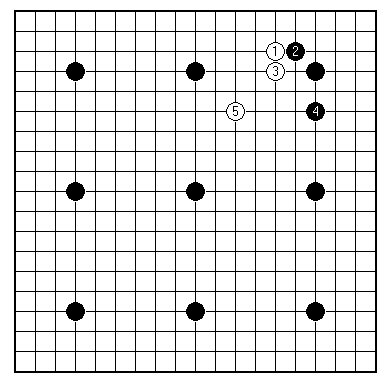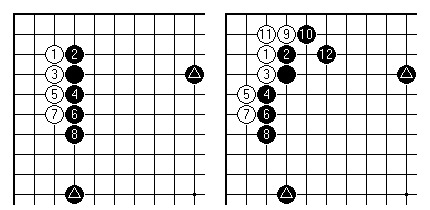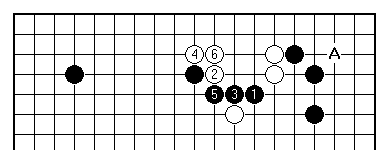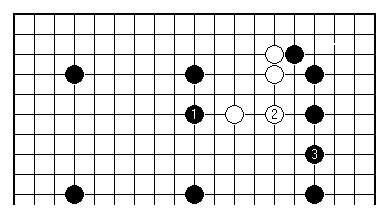

Who's afraid of a big bad dan player? Just as in the martial arts, Go has adopted a system of grades for players, though not indicated by belts of different colours. You can probably tell something about players' standing from the way they carry themselves in the club (come to think of it, neither fashion sense in the way of choice of accessories, nor good posture, is required to play Go). Confusingly enough, there are half-a-dozen Go grading systems for amateurs in operation worldwide; and the ever-larger number of online players encounter scales specific to each server.
Let's concentrate first on the common features and purpose of the usual systems.
Therefore in principle any two scales are easily compared, if you know how a 1 dan player from one would rate on the other one: because the same offset should apply uniformly over the whole of the two systems. For example, European grades are between 1.5 and 2 levels (stones) stronger than those recognised by the American Go Association; and the dan levels on the IGS server are currently thought to be about four stones stronger than the European standard, which would make an IGS 1 dan comparable with a European 5 dan*.
Grades have become built into the tournament circuit - in Europe the McMahon tournament, an adaptation of the Swiss to include players starting at a level representing their grade, is the common system. This leads serious players to place further weight on grades. However, the giving of grades isn't an end in itself (though Go players, not differing in this matter much from the rest of the human race, tend to excessive interest in the hierarchical side). Especially in a club like Dan's, handicaps make for interesting games between players of widely differing standards, where even (non-handicap) games will almost always be won by the stronger player if the grades aren't adjacent. Handicap games are teaching games, and the correct perspective on grades is that they should support teaching, not create minor celebrities.

Here is the start of a nine-stone handicap game, the classic teaching game between players of widely differing strengths. The board is set up with one black stone on each of the small "star" markings. Then White starts. Black's first plays are good, setting up a target for attack. White 5 is a typical handicap game play, and we can learn much from it. [Complete handicap games are covered in the "Big Pro Little Pro" series.]
Let's talk to KUMMERSUM about handicap Go - he's one player here who spends much of his time playing teaching games, giving large handicaps (six or more stones).
As KUMMERSUM tells it: "On the way to 1 dan from novice you have to improve about three times by a whole nine stone handicap. So it's not true that Black must inevitably crush White, with such a large start. Here at Dan's the initial grades are called kyu [pronounced like the letter Q], since we follow Japanese customs in most things. From 27 kyu, which is a beginner with just a little experience, to 18 kyu, a social player, may take a while, or be a matter of a couple of weeks if you are a games maven. From 18 kyu to 9 kyu brings you to club player level. At that point you are ready to surpass any current computer program. You probably drop the "I'm just a beginner" reaction at around 15 kyu, and start to look at some accessible Go literature. Working your way up from 9 kyu to 1 dan is the shank of the matter, and the best fun while it lasts. You can play almost anyone here on handicap and have a chance to win (not GOLD, though - he can give nine stones to a 2 kyu)."
"Handicap play may appear mysterious, until you have contact with an expert player. Three main points:"

And he analyses the example game in those terms.

"Here White gains some advantage because Black is too keen to attack by cutting White. Black 1 and 3 take something in the centre but lose on the upper side - the handicap stone that controlled it has been roughed up. Black should have used it, not treated it as a freebie. In effect White tricked Black into premature aggression. Now White can contemplate invading at A quite soon. White may grind Black down with enough small gains of this sort. In any case White 2 here is a skilful dodging play."

"In contrast this way of playing by Black keeps the whole white formation under pressure, and looks towards building up the top left on a large scale. Imagine Black 1 added into the diagrams of the 3-3 invasion for the proper effect. No doubt White will try something confusing in that area, but Black really has nothing to fear."
* Added 2002:
These points need correcting in the light of what I now
know. IGS grades after a recent change of +3 are such
that IGS 1d is close to EGF 1 dan. The steps between IGS
grades are more like 0.75 of a stone. Grades on the KGS
server are such that KGS 1k is close to EGF 1 kyu, but
in this case KGS kyu grades seem to be a little closer
together (perhaps 0.67 of a stone).
First published 9 March 2000 as On Your Side on MindZine,
Go Learning
© Charles Matthews 2000.